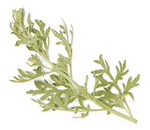
Wormwood
Introduction
This fact sheet provides basic information about Wormwood. Wormwood is an odorous, perennial shrub native to Europe and naturalized in the northeastern, central, and northwestern United States. Its aromatic leaves have a strong sage odor and bitter taste, and its multibranched stems are covered with fine, silky hairs.The name wormwood is derived from ancient use of the plant and its extracts as an intestinal anthelmintic. In Pakistan's indigenous medicinal systems, the leaves and flowering tops are used as an anthelmintic, antiseptic, febrifuge, and stomachic, and to alleviate chronic fever, dyspepsia, and hepatobiliary ailments. An ethobotanical study in Turkey documents the plant's use as an abortifacient, as a blood depurative, and in treating stomach aches. It has also been used as an appetizer. Caribbean folk medicine documents the use of wormwood for menstrual pain, vaginitis, and other unspecified female complaints. Extracts of the plant are used as a bitter seasoning for food and added to drinks such as beer, tea, or coffee. In western European traditional herbal medicine, wormwood was recommended for gastric pain, cardiac stimulation, and to restore declining mental function. French and Spanish New Mexicans used the plant species along with other plants as an emmenagogue. In traditional Chinese medicine, practitioners treated acute bacillary dysentery by applying fresh and dried absinthium. A poultice of the plant has been used medicinally for tendon inflammation, and wormwood tea was used traditionally as a diaphoretic.
Wormwood extract is the main ingredient in absinthe, a toxic liquor that induces absinthism, a syndrome characterized by addiction, GI problems, auditory and visual hallucinations, epilepsy, brain damage, and increased risk of psychiatric illness and suicide. The drink has been banned in several countries, but in the 19th century, absinthe-based liquor was known for its aphrodisiac and healing properties and also was reputed to stimulate creativity. The emerald-green color of absinthe liquor came from chlorophyll; however, copper and antimony salts were reportedly added as colorants to inferior batches, with toxic consequences. Thujone-free wormwood extract is currently used as a flavoring, primarily in alcoholic beverages such as vermouth.
Common Names
Wormwood, Absinthium, Armoise, Wermut, Absinthe, Absinthites, Ajenjo, Pelin Otu, Aci Pelin, ak Pelin, Buyuk Pelin, Vilayati AfsanteenLatin Names
Artemisia absinthiumWhat It Is Used For
- Wormwood was traditionally used to treat worm infestations, although there is no clinical data supporting this use. Anti-inflammatory, antipyretic, and chemotherapeutic activity is documented in nonhuman studies. Information regarding the plant's use in Crohn disease is limited. Wormwood is also used as a flavoring agent.
How It Is Used
Wormwood can be taken in the following forms:- Tea, which can be made by adding 1/2 to 1 teaspoon (2.5 to 5 grams) of the herb to 1 cup (250 ml) of boiling water, then steeping for ten to fifteen minutes. Three cups (750 ml) of tea can be taken each day.
- Tincture, which can be prepared by adding 10-20 drops in water and then taken ten to fifteen minutes before each meal.
- Researchers suggest that wormwood should not be taken for more than 4 weeks consecutively.
What the Science Says
- Wormwood is classified as an unsafe herb by the Food and Drug Administration (FDA) because of the neurotoxic potential of thujone and its derivatives. The safety of wormwood is poorly documented despite its long history as a food additive. Convulsions, dermatitis, and renal failure have been documented.
Side Effects and Cautions
- Avoid use because of documented abortifacient and emmenagogue effects.
- Thujone produces a state of excitement and is a powerful convulsant. Ingestion of wormwood may lead to absinthism, a syndrome characterized by digestive disorders, thirst, restlessness, vertigo, trembling of the limbs, numbness of the extremities, loss of intellect, delirium, paralysis, and death.
Sources
- Drugs.Com Web site. Accessed on February 7, 2009.
- From Wikipedia, the free encyclopedia. Accessed on February 7, 2009.






